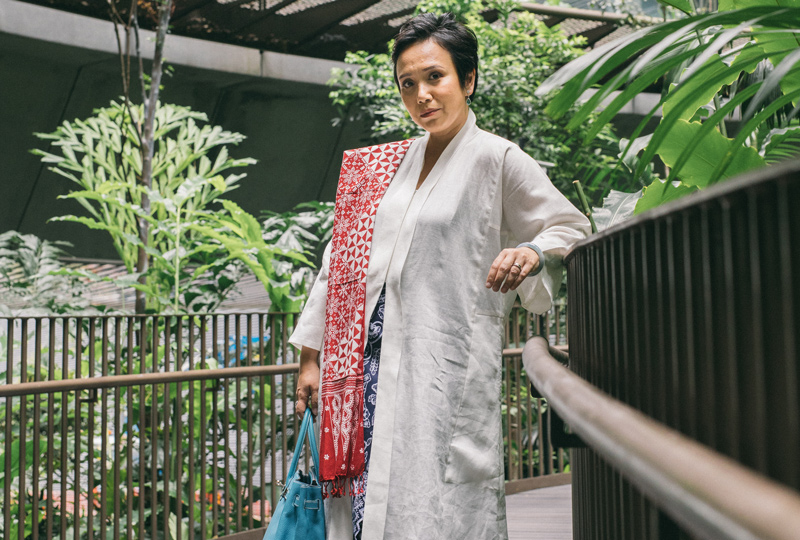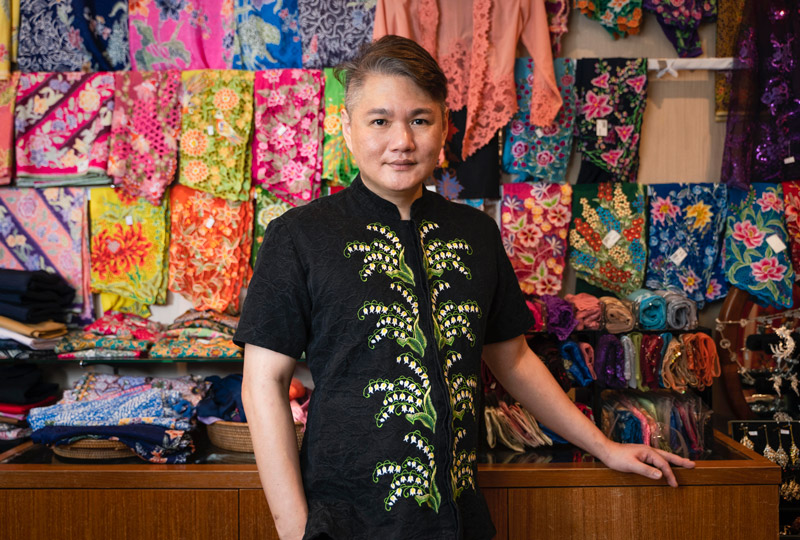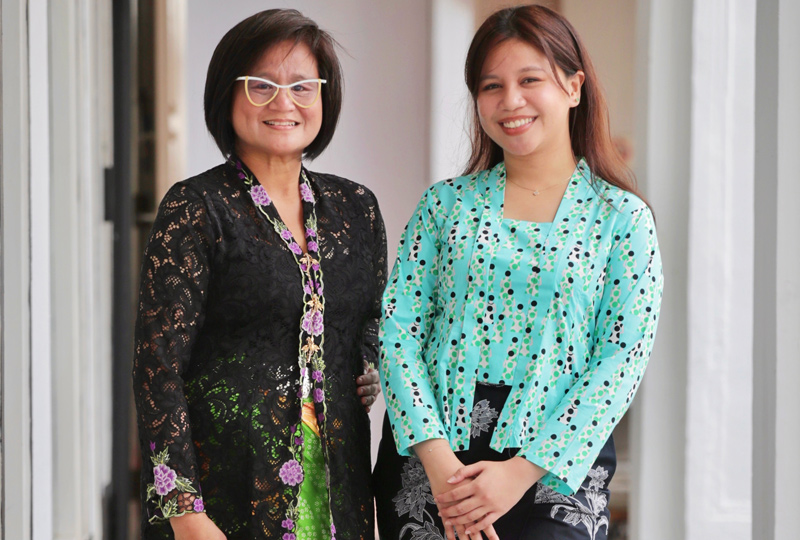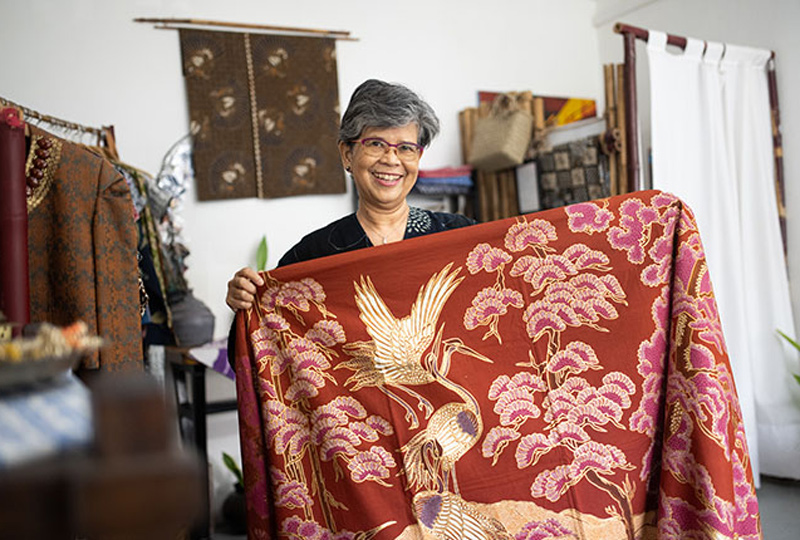Memory. Aspiration. Celebration. History. Power. And one common subject that unifies them all: the kebaya. A garment that needs mere introduction, as any mention of it alone is capable of igniting various mental images in most of us living in these parts of the globe. Here on our local shores, many might instantly relate it to the sarong kebaya worn by The Singapore Girls. Others—like the Peranakan or Malay communities who share stronger cultural ties to the garment—would more likely recall an image of their mothers or grandmothers wearing it during certain occasions.
So it is only natural then, that for a multinational nomination to the UNESCO Representative List of the Intangible Cultural Heritage of Humanity, the kebaya has been submitted as a form of the region’s shared heritage and identity. For which, the National Heritage Board (NHB) has also kicked off a new travelling exhibition titled ‘Love, Kebaya’, currently housed at the National Museum of Singapore. A highlight of the exhibit includes six different kebayas—dreamt up by leading craft makers and cultural entrepreneurs in Singapore—including household names such as Ratianah Tahir behind Kebaya by Ratianah at Kampong Glam, Chinese Peranakan designer Raymond Wong and Oniatta Effendi of Baju by Oniatta and Galeri Tokokita.
Whilst Wong’s lilac-drenched piece sees a focus on the art of embroidery and lacework more commonplace in the Peranakan form of the kebaya, Effendi’s work sees a bold expression of modern femininity: an innovative marriage of the kebaya and the kemben (a female torso-wrap meant to cover the chest). Through just these six designs in the exhibit, it’s become clear that the kebaya transcends its misplaced definitions as mere costume and holds its own in the sartorial realm. What with the multiple ways one can imagine it being adapted for the contemporary wearer, it’s time we shine the limelight on the potential of the culturally rich piece of clothing. In conversation with five prolific kebaya makers and entrepreneurs in Singapore who continue to give life to the storied garment, we dive into the heritage of the garment, what it represents to them and where they see the kebaya in today’s modern context.

1 / 5
Oniatta Effendi, cultural entrepreneur and founder of Baju by Oniatta & Galeri Tokokita
What does the kebaya represent to you?
It represents character. I quote what Puan Noor Aishah, Singapore’s first First Lady, said in her book about first entering the Istana and realising the various roles she had to play: “It was nicer, as opposed to the Baju Kurung.” So I think what she means by that is that the kebaya allows you to embody a certain character; the kind that elevates your individuality or personality.
It also represents power. When worn, it carries a certain weight and meaning, where politics and power are concerned, particularly with women in positions of power themselves such as Sri Mulyani Indrawati, the finance minister of Indonesia, or our own President Halimah Yacob.
Of course, it is also a symbol of aspiration. Just think of how many of us grew up wanting to be an SQ girl—just to wear that iconic kebaya to work.
As a business owner of such a heritaged cloth, how would you describe your role in telling the story of the kebaya?
I would answer this question with a question: What were kebayas worn with? And I think with clues from these old books about fashion’s past and the clothes in those time periods, combined with personal memories of our family members wearing it when we were younger, the answer was that the kebaya was worn with batik. So seeing how it is worn with the batik and vice versa, is where I see my role in this. It’s also about making it relatable and relevant to the modern wearer whom we are facing now.
Another crucial aspect of this business is not losing your regard and reverence towards what is traditional. It’s not difficult to you know, try new ideas, and I think it’s almost always encouraged to innovate. But at the same time, you’ve got to reel yourself back in to ensure that it doesn’t stray away too much into what could not be a kebaya.
How would you say the kebaya has evolved over the years?
Women in the past used to make it themselves. But now, that is not necessarily the case that the craft has left. You know, it’s not in every woman’s household any longer. That being said, that allows us to play with what we have seen. And then, what we want to see in the modern era. I’m still finding ways in which we can make it accessible to the current spaces—whilst still holding a certain level of reverence and regard to the traditional form, or the original form.
Why do you think the kebaya is still ever-significant today?
The kebaya has never left us. It’s there. But we need to reframe the way we look at things. The kebaya is present because of how it was. We have grown up looking at women in our lives wearing it. And as we come into this space now in understanding what it means, we are asking ourselves questions of what the kebaya represents. So we’ve become that discerning wearer that wants it to be able to take on certain meaning. What do we want it to say about us and what’s next for the kebaya?
The ‘what next’ question is about how we re-present it moving forward. It’s about how we re-present the kebaya; through an invitation of discourse, and conversations that allow us to continue to make this living, cultural artefact live on in our future spaces.

2 / 5
Mr Raymond Wong, designer and craftsperson of Rumah Kim Choo
What does the kebaya represent to you?
So to me, kebaya is a symbol of change. Because it is symbolises that our community, is not a static group of people. We are always evolving and adapting according to the times, and the different fashion styles of nyonya kebayas are testament to this. With Westernisation and modern fashion trends that started popping up in the ’50s and ’60s for example, kebaya wearers wanted to make the waist look more accentuated. Whilst the younger generations of the ’70s preferred less embroideries and experimented with interesting fabrics and psychedelic prints instead.
As a business owner, how would you describe your role in telling the story of the kebaya?
I would sometimes conduct in-house tours and talks—where I would talk about the nyonya kebaya and its evolution. I would also sometimes take out my vintage collections, which people often love to admire. My role is also to educate them; and to make them think about whether there are ways to extend the kebaya past its regular vernacular. To alter perspectives and try to see if there are ways to make it as daily wear as well. I also look at enhancing their knowledge about the materials, craft and techniques involved in making the kebaya.
How would you say the kebaya has evolved over the years?
More women are increasingly willing to experiment with the wearing of the kebaya, by wearing it with pants rather than just the sarong for example. Back in 2009, I also started putting crystals on the kebaya—which also appealed to brides who felt like it was a good way to make them look more glamorous. There are also more interesting forms that have been requested for, such as jacket suits, that reflect the younger generation’s needs and their modern take on the kebaya.
Why do you think the kebaya is still ever-significant today?
It’s like the Japanese kimono or the Korean hanbok. The kebaya is always relevant to our society, but yet it is not affected by modern fashion trends. So it’s an evergreen dress that will always be suitable for any occasion. And it’ll always make the woman look dignified, feminine and elegant at the same time.

3 / 5
Ratianah Tahir, founder-designer behind Kebaya by Ratianah
What does the kebaya represent to you?
The kebaya is an apt symbol, a unifying representation for the women in our culture and region. When you don the kebaya, it makes you feel confident and elegant. It is flattering to the female form and reminds you of the strength of the women who had previously worn it too. It is an inherent part of our history, intangible culture in a tangible form.
As a business owner of such a heritaged silhouette, how would you describe your role in telling the story of the kebaya?
When a customer comes in to purchase a kebaya, my first question will be “What kind?”. Our retail shop offers many different kind of varieties that most are often unaware of. Many have forgotten that the kebaya itself has many iterations; from long to short, fitted or loose and in all sorts of fabrics and silhouettes. I believe my role here is to aid them in the experience of discovering the kebaya. I hope to bring back the romance in kebaya.
How would you describe your personal relationship with the kebaya?
Growing up, I saw all these beautiful ladies in all sorts of shapes, sizes and colour donning the kebaya. They wore them daily; to work and formal functions, to the market, running errands and even whilst doing the laundry. It is identifiable too, especially when you’re overseas. You automatically feel a sense of familiarity when you see others in it. In a sense, it is a thread that binds. I wear the kebaya. My mother wore the kebaya, and her mothers before that. I hope my daughter and her daughters will wear it proudly too.
How would you say the kebaya has evolved over the years?
In traditional Malay attire, we mainly have the baju kurung and baju kebaya. To differentiate, the kebaya is essentially a front-opening garment. It’s origins have been said to have been derived from the Abaya, a long robe-like outer garment that has assimilated into the local culture. Over time, many more variations, lengths and silhouettes of the kebaya have emerged, in all sorts of fabrics. Within the Malay Archipelago, you are also able to see heavier embroideries that can be done commercially as well. Externally, hybrid influences and pop culture play a part as well, especially when it comes to its terminology in the fashion world.
Why do you think the kebaya is still ever-significant today?
The kebaya has already prevailed for hundreds of years, I don’t see a reason why it should wane now. It is iconic. A number of my designs that is very popular with the younger crowd still maintain and pay respect to the silhouette of the kebaya, but with a fresher take. I play with the fabrics, prints, colours and fit that appeals to the modern day woman. No matter how modern and globalised we are, it is heartening to see many adopting this beautiful garment and wearing it proudly.

4 / 5
Designer Sufiyanto Amat Sopingi & fashion business consultant Muhammad Afiq Juana, the duo behind @kebaya.societé
What does the kebaya represent to you both?
To us, the kebaya is an iconic garment of expression in women’s fashion. People have always attributed meanings to clothing. The kebaya has been linked to notable women from the region—from politicians to royalty and celebrities. Not forgetting, our own aunts, mothers and grandmothers. The kebaya is synonymous with the wearer, embodying their values, identity, culture, heritage and what they represent to each individual.
How would you describe your personal relationships with the kebaya?
Sufi: As non kebaya-wearers, our appreciation for the kebaya lies in its ability to represent values that we hold close to our hearts and empower the special women in our lives. As the kebaya is deeply rooted in our heritage, the interest and curiosity to collect and study the various kebaya from different eras came naturally to me—as a tailor. The pieces in our collection range from the 1900s to 1980s, and each one has its own uniqueness in construction and silhouettes.
How would you say the kebaya has evolved over the years?
Fashion isn’t static and constantly changing. The kebaya has been changing since as early as the 1930s and every piece has its own history. An example of this is the “kebaya saloma”; a contemporary kebaya popularised by 1950s singer Saloma Ismail, that omits the front lapel and collar altogether. Similarly, there’s also the Singapore Airlines kebaya, with its rounded scoop neckline. Whilst traditionalists today argue that these styles are not kebaya styles, fashion magazines did refer to these styles as kebaya back then. The kebaya like many other garments, will continue to change, keeping up with current trends.
What would you say is @kebaya.societe‘s role in all of this?
Our goal has always been to expand the vocabulary of fashion in and of the Malay Peninsula and Nusantara. Not many Instagram accounts showcase vintage Malay Nusantara fashion, and we felt visibility would be important. More importantly, we aim to ignite curiosity and interest from those who are currently unaware about their culture and heritage. Our platform has also allowed us to highlight our commonalities, yet also what makes each of our cultures unique.
Why do you think the kebaya is still ever-significant today?
The kebaya is about cultural authenticity and identity. Whether that stems from growing up seeing strong matriarchs wearing the kebaya, to recreating past signature looks worn by fashion icons and national pride. And to many living abroad, the kebaya is also a reminder of home.
What are some interesting opinions on the kebaya that your followers have shared with you?
We’ve received a handful of messages who disagree with our promoting the kebaya because it doesn’t align with their values—which we respectfully disagree with. We’ve also had open dialogues and discussions with designers, creatives and the general public about the relevance of the kebaya today and what the future of the kebaya is. Many have shared images of themselves or old photos of their family members in kebaya and their stories. Many have reached out to their mothers and grandmothers, rummaging through their closets in search of a vintage kebaya they can wear, keep and cherish. What is more common is the discussion of how a garment is able to bring and unify different nations, countries and communities together.

5 / 5
Yati Hairi, founder-designer behind Kiah's Gallery
What does the kebaya represent to you?
Kebaya represents celebration. It is something you’ll wear during a wedding or Hari Raya, perhaps.
How would you describe your personal relationship with the kebaya?
My mother used to love dress up in the kebaya when she was younger. She would design and sew her own creations. Whenever I see the kebaya, I would get nostalgic and giddy in anticipation of the joy it is able to create.
As a business owner of such a heritaged silhouette, how would you describe your role in telling the story of the kebaya?
I think the kebaya holds a beautiful story of its own. From the pattern of the fabric to how it falls on the body, my job is to augment its beauty by guiding customers along the process and witness that transformation.
How would you say the kebaya has evolved over the years?
As it passes through generations, its cultural influence only becomes stronger. But customisation using collars, jewellery, buttons and embroidery is just something I’ve noticed that customers use to make their pieces truly theirs. It does not always need to be figure-hugging. As long you’re comfortable, it is easy to pull the kebaya off.
Why do you think the kebaya is still ever-significant today?
To me, it will always be significant. It represents a cultural upbringing and has a beautiful past. Someone could even be pairing it with jeans or a blazer. This is something I hope more people will be willing to experiment with—whilst honouring its past.





